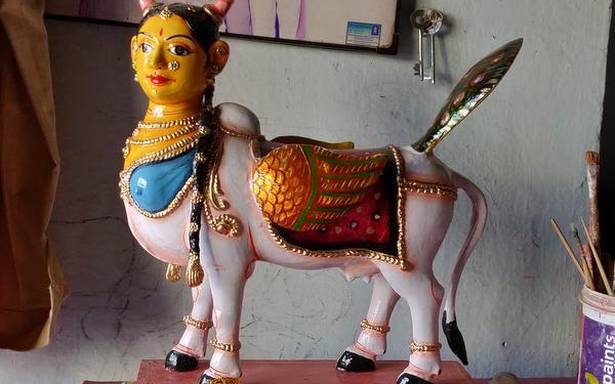ART NEWS
Social media is giving a boost to the artisans of Kinnal and their wooden dolls
Kinnal art, awarded a GI tag in 2012, is enjoying a resurgence powered by an artisan’s Instagram page
Santoshkumar Chitragar, 28, an artisan from Kinnal (also spelt Kinhal) in Karnataka is a busy man these days. When he’s not working in his studio crafting the exquisite Kinnal dolls, he is busy closing orders on Instagram, attending conference calls with clients, getting packages shipped or organising training programmes for his fellow craftsmen. It’s a stark contrast to his routine a year ago, and Santosh is enjoying every bit of it. “I have been making Kinnal idols since my childhood, a craft I picked up from my father and grandfather. It has always been my dream to keep the legacy alive, and Instagram has really helped,” says Santosh.It was during a Kinnal workshop four years ago at the Indira Gandhi National Centre for the Arts, Bengaluru, that two students introduced Santosh to social media, and opened an Instagram account for him. Seeing tremendous traction over the past year, the platform has given Santosh visibility and a chance to reach out to customers not only in India but across the globe. The account itself is managed by Santosh’s friend Nagaraj Bakale, a painter from Gadag. According to Bakale, they regularly receive orders from countries including the U.S., Germany and Canada. Buoyed by their success, the two have also started a Facebook page, and receive a steady stream of enquiries from overseas. Kinnal, a sleepy village in Koppal taluk, is home to the eponymous craft that was awarded a Geographical Indication tag in 2012. The chitragars, as the traditional artisans are known, fashion brightly coloured, lightweight toys and religious idols from a local variety of wood called Polki Marra, which grows in and around Jabbalgudda village, about 30 km from Koppal. The themes are mainly mythological — idols of deities including Hanuman, Garuda, Gowri and Durga are among Kinnal’s signature creations. Many of the artisans are also involved in making larger idols for the local village festivals, or ooru habba, along with paraphernalia such as palanquins, cradles and chowkis.
The craft dates back to the 15th or 16th century, and is thought to have gained prominence and patronage under the Vijayanagara Empire, and later, the Nawabs of Koppal. The intricate carvings on the famous Hampi chariot are believed to be the handiwork of the ancestors of the chitragars of Kinnal. Intricate processThe products are entirely handmade, and the first step involves sketching a rough outline of the required figure on a wall using charcoal. Blocks of wood are then chiselled to make individual components such as the head and limbs. The parts are joined using a paste called kitta, made by mixing boiled tamarind paste with jute rag pieces and neem wood powder. The latter protects the idols from termite attacks. Once the pieces are joined together, the idol is again given a thick coat of liquid tamarind and pebble powder. After this, the finer aspects such as the eyes and nose are etched out. The idol is then covered with pieces of thin cloth and chalk powder before being painted. Painted using watercolours or enamel, the signature colours of Kinnal are red, green, yellow and black. You’ll also find a few idols coated in a stunning gold finish. “While some artisans use enamel paint for gold, the authentic way is to use the lajawara technique — a trade secret. It is prepared by hand-beating sheets of tin, which results in a powder that when processed further yields silver and then gold paint. It is a very expensive and tedious process,” says Santosh, who is one of the very few artisans to have mastered this technique. His gold-coated heads of the goddess Gowri are among Kinnal’s most popular products. For all budgets Some dolls are available for as little as ₹150, but there’s a vast range of prices. For instance, there’s an intricately made six-inch Gowri head that costs ₹6,000, whereas a 24-inch idol crafted completely in lajawara gold comes to almost ₹3,65,000.
Kinnal is currently home to 67 families of chitragars, about half of whom pursue the craft — a number that’s dwindling fast, as in all handicrafts. Santosh, however, has been able to persuade a few fellow artisans to take up the craft full-time, and has been giving them regular work from his Instagram orders. “Santosh has been outsourcing a lot of his work to at least five or six artisans including me, so we have decided to do this full-time” says Ramu S. Chitragar, 27. He adds that his uncle has now regained an interest in the craft and helps him out. Santosh recently organised a month-long training programme for about 30 members of the community, including 20 women, in association with the Export Promotion Council for Handicrafts and the Development Commissioner, Handicrafts. He has also coordinated the procurement of individual GI certificates for artisans, as proof of their products’ authenticity. “It is important for us to understand the nuances of marketing, upgrade our skills, and also create new designs for the changing times,” says Santosh.The freelance writer from Bengaluru has a passion for travel, culture, food and design.











